Home
"By denying scientific principles, one may maintain any paradox." - Galileo Galilei
Lombard's Paradox
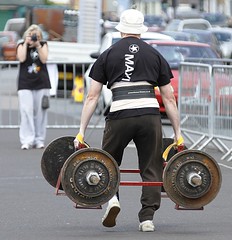
Preamble
It was 1989 and I was at Brighton University studying Sports Science. I had a scientific revelation regarding muscles which cross 2 joints (bi-articulate muscles) such as the hamstrings, quadriceps, biceps and triceps.
The standard explanation in any text book is that this is so the muscle can perform two joint functions - for example the quads are said to extend the knee as well as flex the hip.
This seemed to me to raise more questions than answers. For example if the quads contracted so as to extend the knee then it would require a muscle at the other end to stop the hip flexing. If the quads contracted to flex the hip, it would require a muscle at the other end to stop the knee extending. Thus 3 muscles would be needed to control something that would have required only 2 muscles.
And what about if I stood up? The quads would be extending the knee but opposing extension at the hip. It seemed a stupid design, or more likely a stupid explanation of the design.
The Revelation
-
My first thought was that the quads and hams must be acting more like non-contracting cables.
-
The second thought was that that the moment arms must be different at each end so that contracting the quads and hams at the same time would extend the hip and the knee at the same time (as in a jump or a squat).
-
The third thought was that this would shift the bulk of the muscles to the centre of the body (like that of the Ostrich leg)...
Naturally it turned out that my great discovery was proposed by Warren Plimpton Lombard (1855-1939) as I discovered in Rasch & Burke 1978 text "Kinesiology and Applied Anatomy: The Science of Human Movement" in the University library.
Mechanics
The first thing I decided to do was to compare mono- and bi-articulate versions of the quads and hams. I made a simple model like this;
Quads and Hamstrings
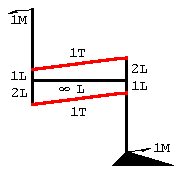 B
B 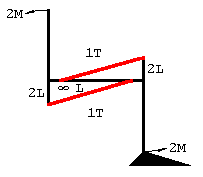
I then calculated the torques of A and B like this;
L - length
T - tension
M - moment
T×L = M, note that I've defined the femur as being infinitely long so as to make for simple calculations - in effect the muscles pull parallel to the femur.
A Moment at knee is Quads minus Hams; (1T×2L)-(1T×1L) = 1M, moment at hip is Hams minus Quads; (1T×2L)-(1T×1L) = 1M
B If the Quads and Hams only crossed two joints the respective moments would 2M.
Thus the mono-articulate version generates twice the torque at the foot compared to the bi-articulate model.
I then calculated the Work output of A and B like this;
W - work
L2-L1 - change in length of muscle
T×(L2-L1) = W
A Work at Quads and Hams; 1T×(2L-1L) + 1T×(2L-1L) = 2W
B Work at Quads and Hams; 1T×(2L-0L) + 1T×(2L-0L) = 4W
Note that I am assuming that the starting position is as in A and B and that the finish position is with the joints all straight. Thus twice as much work is performed in B, however the muscles in A contract by 1L whereas the muscles in B contract by 2L.
Thus the mono-articulate version generates twice the work compared to the bi-articulate model A and B.
However if B is modified as in D then the mono- and bi-articulate are identical in terms of torque and work in that they generate 1M torque and 2W work;
 D
D 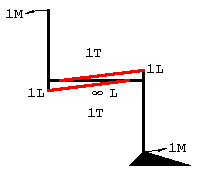
Physiology
At this point it helps to know a little physiology. If in A and B both involve the same efficiency of work transfer yet A involves only half the amount of change in muscle length to achieve the same degree of angular limb displacement as in B then it seems obvious that this is a form of gearing.
To put it another way if A can achieve higher limb velocities than B for equal speeds of muscle contraction. It might seem that this would be at the expense of producing force but when muscles contract more slowly as in A then they can achieve higher forces as in E - so the loss of leverage in A is partly cancelled by the gain in the FV curve of E. Furthermore because muscle length changes less in A so the muscle can spend more time in its most force producing area as in F where it would want to be near a force peak during say the heel strike of a run.
FV Curve and LT Curve
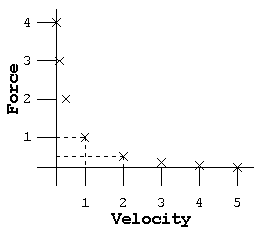 F
F 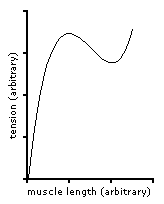
Thus bi-articulate muscles might be seen as being equivalent to high gears on a bicycle - they allow the legs to move faster without the muscles having to contract as fast as they would have to in a mono-articulate system.
At this point it might be asked why not just use then use D instead of C?
Transferring Force
When doing a leg extension the hams do not contract, from A it can be seen that if they did then the moment at the knee would be reduced. So a bi-articulate Lombard muscle can act like a gear during a compound movement A but like a high force mono-articulate muscle B during an isolation movement.
During a squat like movement hip extension strength is large due to the glutes, in fact in a power squat this hip extension strength is utilised by keeping the shins fairly vertical;
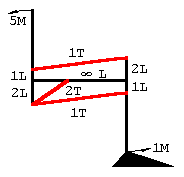 H
H 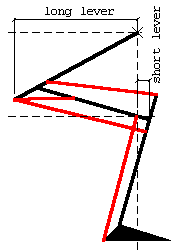
Here I've included the glute muscle which is mono-articulate. It adds to hip extension strength. It can be seen in G that the moment at the hip is now 5M whilst that at the knee is 1M. This means that when performing a squat one must arrange the body so that the horizontal leverage at the hips is big compared to that at the knees as in H.
The glutes are large because they must lever the whole leg. The rest of the leg is thus kept lighter so that a great mass does not have to be swung about - this is most prominent in running animals which have stick like legs with the muscle all concentrated at the top. Note the calf is also a bi-articulate muscle that is in effect channeling force from the glutes.
Disengaging the hams from a squat move would increase knee extension strength it would also decrease hip extension strength - hip force would be 3M and knee force 2M, total torque would thus be 5M compared to 6M G.
The Bi-Articulate Upper Body
The biceps and triceps seem to be geared towards pulling toward the body I;
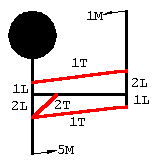 J
J 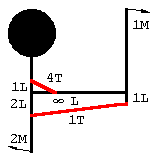
I seems to favour pulling fast toward the body, perhaps this is an arrangement suited to animals whose forelimbs are arms. Due to the lats adding to the upper arm adduction strength of the triceps, the torque around the shoulder is greater than that at the elbow - so during a chin-up the forearm is relatively vertical (like the shins in a squat).
During a curl type move the triceps would disengage so that greater curling force would be evident compared to tricep extension strength (where the biceps would disengage).
When hanging from a bar the biarticulate arrangement also keeps the joints together, for example the elbow is held together by 2T of force 1T either side of the joint. If only the bicep were to contract the joint would be held together by 1T of force. Perhaps this joint stabilising ability in the upper arm when pulling is a hangover from our brachiating ancestors.
The gearing system of the biarticulate triceps is evident in J where the biceps disengage and the shoulders power the arm straight via the triceps. In this case the biarticulate muscle is more powerful than if it were monoarticulate due to graph E.
Another advantage of the biarticulate system is that during a compound movement the joints are held together by the forces either side of the joint I. This joint stabilisation feature is also evident in H, thus during a squat the knee ligaments are probably under less stress than in a leg extension. In a leg extension the full force of muscular contraction goes into displacing the tibial plateau anteriorly. Similarly in a leg curl the tibial plateau is displaced posteriorly. It maybe that people undergoing rehabiliation from cruciate injuries are best off doing leg presses or squats rather than leg extensions or leg curls.
Upper Body Pressing
During a shoulder press or a shot put the biceps disengage so as to allow extension at the shoulder and elbow J. This would then allow the triceps to act in a gear/cable like fashion at the elbow via the power of the shoulders and triceps. Lombard's paradox is not exhibited. The triceps have poor leverage but their strength is enhanced because they move at only half the speed of that in a monoarticulate example they can therefore generate more force (E).
Summary
-
Lombard's paradox is that of the co-contraction of apparently antagonistic muscle groups.
-
The paradox can to be explained by the different leverage ratios that biarticulate muscles exhibit - in the case of the legs it causes extension at hip, knee and ankle, whilst in the arms it causes shoulder and elbow flexion.
-
Bi-articulate muscles act like gears, increasing the speed of compound moves by acting in cable-like fashion or acting in mono-articulate fashion to increase the force of isolation type moves.
-
When acting in Lombard fashion bi-articulate muscles keep the arms from being pulled apart and the legs from being displaced.
Reading
-
K.Radkhah and O.Vonstryk Exploring The Lombard Paradox In A Bipedal Musculoskeletal Robot Department of Computer Science, Technische Universität Darmstadt
-
Rasch & Burke 1978 http://www.clinicalgaitanalysis.com/teach-in/lombard/
23rd September 2023